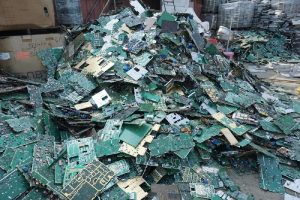
Tedd Lister and Luis Diaz-Aldana, researchers with Idaho National Laboratory’s biological and chemical processing department, found that electrochemical recovery (ER) of materials from e-scrap involves significantly lower capital investment, emits less pollution and uses fewer chemicals than alternative processing technologies.
“Lower capital investment, waste generation, and simplicity make the ER process a viable alternative for the processing of e-waste in the United States,” the researchers wrote in a recent report. “Using primarily electricity as a reagent, the ER process can produce metals using renewable energy and thus may become an even more attractive option in the future.”
In an interview with E-Scrap News, Lister and Diaz-Aldana expanded on their recent report, which was published in the academic journal Waste Management and titled “Economic evaluation of an electrochemical process for the recovery of metals from electronic waste.” Their research, which has also been published in a handful of other journals, was funded in part by the Critical Materials Institute, an initiative of the U.S. Department of Energy.
Higher ROI
Electrometallurgical processing uses electricity for metals recovery, rather than heat in a smelter. It’s a “much less intense process than a thermal process,” Lister said. It also differs from a standard hydrometallurgical leaching process, which requires the use of a lot of chemicals.
In an e-scrap process employing ER, shredded material would first go through magnetic separation to remove ferrous materials. Everything else would be moved into “extraction columns,” which are essentially chambers where the materials mix with leaching chemicals.
After it exits the leaching process, the metals-rich solution goes through an electroextraction process, which extracts a tin-copper bronze powder and leaves a solution containing gold, silver and palladium. That solution can then be further refined to recover the precious metals.
The ER process presents several key distinctions from its counterparts. Unlike smelters, the ER method does not produce dioxins, avoiding air regulatory issues. ER also differs from hydrometallurgy in its chemical costs. Hydrometallurgy involves heavy usage of reagent substances, whereas ER uses primarily electricity and is able to reuse most of the reagents it does require. “You are not wasting a lot of chemicals. You’re re-utilizing the same chemicals,” Diaz-Aldana explained.
The researchers found ER can reduce e-scrap processing costs from $12.80 per kilogram to $9 per kilogram, compared with traditional smelting. And they found that 2.9 kilograms of scrap electronics can be processed per dollar of capital investment with the ER process, compared to 1.3 kilograms per dollar with a black copper smelting process.
“The biggest difference, and the reason we feel we have an advantage, is it’s simply cheaper to build the electrochemical recovery than smelting,” Lister explained.
Any drawbacks are more likely to become clear in the process of scaling up, the researchers noted. Their study uses “nth-plant assumption,” which means it assumes any hitches and bugs with scaling up the technology have been worked out and aren’t factored into the results.
As it stands, one of the cons compared with smelting is the byproduct. In a smelter, the plastic from e-scrap is burned and acts as a reductant, meaning it provides energy in the smelting process. But the ER process leaves it as a solid waste. Hydrometallurgical processes are in the same boat, Lister added.
Next steps
The research team plans to continue studying and refining its electrochemical system. For example, they want to study how to avoid landfilling the the solid waste byproduct.
Next, it’ll be a matter of working with processors to scale up the technology to the commercial level. New processing operations are key candidates to employ the technology, and that’s the situation the economic analysis studied. It could be more expensive or difficult to retrofit this process into an existing facility.
Special considerations for ER operations could include siting issues, because of the large amount of electricity required to make the process viable. Lister noted facilities using this technology could be located in areas where electricity is generated, such as wind farms.
To learn more, contact Lister at tedd.lister@inl.gov.
More stories about technology
- Project brings rare earth recovery into e-scrap facility
- E-scrap sector continues solar processing push
- E-scrap magnet recycling company scales up